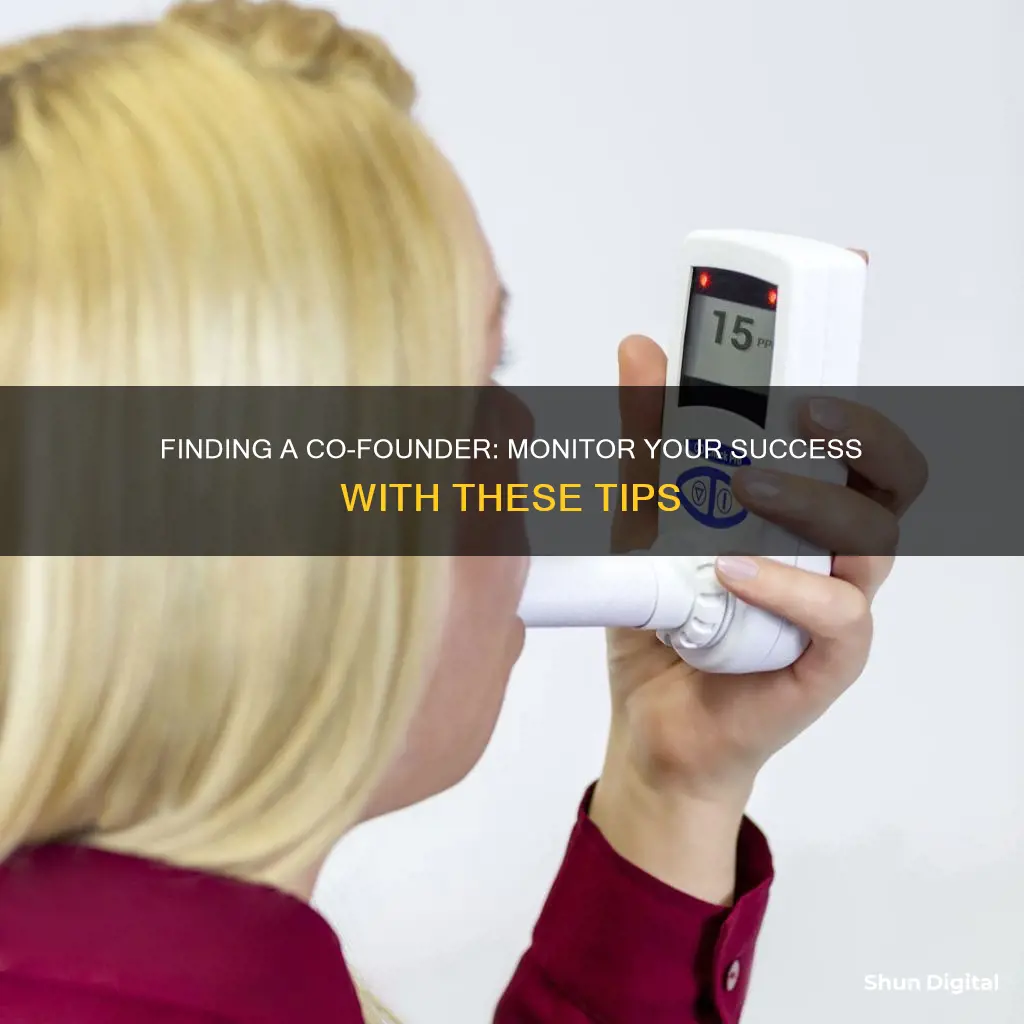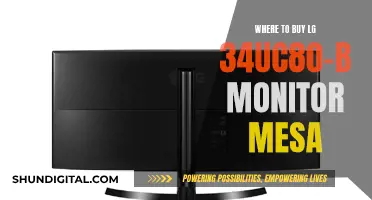
Carbon monoxide (CO) is a dangerous, colourless, odourless, and poisonous gas that results from the incomplete burning of carbon-containing fuels. It is known as the silent killer as it is hard to detect without a sensor, and at least 430 people in the US die from accidental CO poisoning every year. To prevent CO poisoning, it is important to install CO monitors in your home, especially if you use fuel-burning appliances like heating systems, water heaters, or vehicles in attached garages. CO monitors should be placed on every floor of the home, near sleeping areas, and away from fuel-burning appliances. They should be installed at least 5 feet off the ground or on the ceiling, as CO is lighter than air and rises in the event of a leak. Regular testing and maintenance of CO monitors are crucial to ensure their effectiveness in detecting CO leaks and keeping your family safe.
What You'll Learn

Where to place CO monitors
To protect yourself and your family from carbon monoxide, it is important to place carbon monoxide detectors in the right locations in your home. Here are some tips on where to place CO monitors:
- Install at least one CO monitor on each level of your home, including the basement and attic.
- Place monitors near bedrooms to ensure everyone can hear the alarm, even when asleep.
- Put a monitor near an attached garage, as cars release carbon monoxide when running, and the gas can seep into your home if a car is left running in the garage for too long.
- Place monitors at least five feet above the ground or a few feet below the ceiling, as carbon monoxide is lighter than air and distributes evenly throughout a room.
- Keep monitors at least 15 feet away from fuel-burning appliances, such as stoves, ovens, fireplaces, boilers, and dryers, to avoid false alarms.
- Don't place monitors in humid areas like bathrooms or saunas, or in places with too much or too little air circulation, such as near windows or doors, or inside walls.
- Place monitors in locations where you spend the most time, and ensure the alarm is loud enough to wake you up in an emergency.
- If you only have one monitor, place it near the sleeping areas.
- Test your monitor's placement by sounding the warning tone before permanent installation.
- Check your local building codes and state laws for any specific regulations on CO monitor placement.
How to Connect KRK Monitors to a Preamp
You may want to see also

How to test a CO monitor
Testing your carbon monoxide (CO) detector is a simple but important process. CO is a deadly gas that claims many lives each year, so it's crucial to ensure your detector is working properly. Here's a step-by-step guide on how to test your CO detector:
Test the Alarm Circuitry:
- Find the test button on your detector. It's usually located next to an LED light that flashes periodically.
- Press the test button. If the circuitry is working, the alarm should sound for 3 to 5 seconds and then turn off automatically. This test checks the battery and electronics of the unit.
- If the alarm doesn't sound, try changing the batteries. If it still doesn't work, the detector may be faulty and needs to be replaced.
- Repeat this test once a month to ensure your detector is always functioning properly.
Test the CO Sensor:
- Purchase a CO detector tester spray from a home improvement store or online. This non-flammable aerosol spray is designed specifically for testing CO detectors.
- Follow the manufacturer's instructions for using the CO test spray.
- Use a plastic bag to tightly enclose the CO detector and the test spray nozzle. Spray the canned CO test spray for at least 3 seconds.
- If the detector is working, it will sound the alarm within 15 minutes, indicating a level of over 500 parts per million.
- If the detector doesn't go off, try changing the batteries. If it still doesn't work, replace the unit.
- Remove the test bag and sprayer, and fan the detector with fresh air. Press the test/hush button to turn off the alarm.
- Repeat this CO sensor test annually to ensure your detector is sensitive and functional.
Additional Tips:
- Install at least one CO detector on each floor of your home, preferably within 10 feet of bedrooms.
- Replace your CO detectors every 10 years or whenever they fail a test.
- Clean your CO detector regularly to remove dust and debris that may hinder its performance.
- If your detector is hardwired into a home security system, inform your security company before testing to avoid false alarms.
Privacy Concerns: Hotels Monitoring Guest Internet Activity?
You may want to see also

How to install a CO monitor
Installing a CO monitor is a simple process, but it's important to get it right as it's a life-saving device. Here's a step-by-step guide on how to install a CO monitor:
Firstly, you need to decide on the location of your CO monitor. It's recommended to have a CO monitor on each floor of your home, ideally on any level with fuel-burning appliances and outside sleeping areas. The United States Environmental Protection Agency (EPA) suggests placing a CO monitor on a wall about five feet above the floor, or at eye level. You can also put it on the ceiling, around six inches from the wall. Make sure the monitor is away from direct sunlight, blowing air, windows, and humidity. Keep it out of the reach of children and pets.
Once you've decided on the location, follow these steps:
- If your CO monitor requires drilling, trace and drill holes and hang the mounting bracket.
- Insert fresh batteries into the CO monitor.
- Test the device by pressing and holding the test button. You should see lights and hear an alarm.
- Attach the CO monitor to the mounting bracket.
Remember to test your CO monitor regularly and replace the batteries at least once a year. Also, make sure to follow the specific instructions that come with your CO monitor for optimal performance.
The Acer LCD V173 Monitor: Compact and Sleek Design
You may want to see also

How to maintain a CO monitor
Maintaining a CO monitor is essential to ensure its accuracy and effectiveness in detecting carbon monoxide leaks. Here are some detailed instructions on how to maintain your CO monitor:
Placement:
It is important to place your CO monitor in the right location to maximize its effectiveness. Install CO monitors on every floor of your home, including the basement. Place them near sleeping areas, ideally within 10 feet of bedroom doors, to ensure that the alarm can be heard and wake up household members in case of an emergency. Additionally, put a CO monitor near or over any attached garage, as car engines produce carbon monoxide when running. Keep the monitors at least five feet off the ground or on the ceiling, as carbon monoxide is lighter than air and rises in the event of a leak. Avoid placing monitors near fuel-burning appliances, humid areas like bathrooms, or sources of blowing air such as fans or open windows, as these factors can interfere with the sensor's accuracy.
Regular Testing and Cleaning:
Regularly test your CO monitor to ensure it is functioning properly. If it is battery-operated, test the detector weekly and replace the batteries at least every six months to once a year. Vacuum your CO monitor once a year to remove dust and particles that could clog the sensors and affect their performance. Refer to the manufacturer's instructions for specific testing and cleaning guidelines.
Replacement:
CO monitors have a limited lifespan, and their sensors may degrade over time. Replace your CO monitor every five to seven years, depending on the manufacturer's recommendations, to ensure its accuracy and reliability.
Integration with Other Systems:
Consider integrating your CO monitor with other smart home devices or voice assistants. For example, some CO alarms can be connected to IoT devices or voice assistants like Alexa, allowing for remote monitoring and voice commands.
Education and Awareness:
Familiarize yourself and your household members with the symptoms of carbon monoxide poisoning, which may include headaches, nausea, dizziness, and confusion. Know the appropriate actions to take if your CO alarm sounds, such as opening windows and doors, turning off fuel-burning appliances, and evacuating the premises.
Full HD Monitor Sizes: Understanding the 1920x1080 Standard
You may want to see also

How to prevent CO poisoning
Carbon monoxide (CO) is a colourless, odourless, and deadly gas produced by the incomplete burning of carbon-containing materials, such as natural gas, coal, wood, or oil. It is dangerous because it replaces oxygen in the blood, causing serious health issues and even death. Here are some detailed instructions to prevent CO poisoning:
Know the Risks
Understand that anything that burns fuel, such as a furnace, fireplace, generator, gas appliance, or vehicle, produces CO. When equipment is not properly maintained or vented, CO can accumulate and reach dangerous levels. At lower concentrations, symptoms may include headaches, dizziness, nausea, and chest pain. Higher concentrations can quickly lead to loss of consciousness and death.
Keep Vents Clear
Ensure that the outside vents for your gas dryer, stove, furnace, and fireplace are not obstructed, especially after a storm or during winter when snow can block these critical exits for CO.
Proper Ventilation
Proper ventilation is critical. Do not start a car, grill, stove, or generator in a closed area like a basement or garage. Even with the door open, CO can quickly build up to toxic levels.
Regular Maintenance
Have your fuel-burning appliances, such as furnaces, fireplaces, water heaters, and stoves, installed and regularly maintained by qualified professionals. At least once a year, get them inspected to ensure they are functioning correctly.
Clean and Well-Vented Fireplaces
Keep wood-burning fireplaces and stoves clean and ensure the flue is working properly. Keep the flue open even when the fire is just smouldering to allow gases to escape.
Install and Maintain CO Alarms
Install certified CO alarms on every level of your home, outside sleeping areas, and near bedrooms. Test them frequently and replace batteries as recommended. Some CO detectors can be interconnected, so when one detects an issue, they all sound an alarm. If the alarm goes off, immediately evacuate and call emergency services.
Monitoring Web Usage: Strategies for Tracking Online Activity
You may want to see also
Frequently asked questions
CO monitors should be placed in areas that are most strategic and prone to gas leaks. Install a CO monitor on every floor of your home, including the basement, and near sleeping areas. They should be placed at least five feet off the ground or on the ceiling, as CO is lighter than air and rises in the event of a leak.
The number of CO monitors you need depends on the size of your home. For a three-bedroom, two-storey house with an attached garage, three CO monitors are sufficient.
Testing a CO monitor is similar to testing a smoke alarm. First, alert your home security company and place your system in test mode. Then, hold the "test" button until you hear two beeps, release your finger, and then hold it again until you hear four beeps. If you hear four beeps, a signal was sent to the monitoring station. After 10-15 minutes, the CO monitor will exit test mode.







